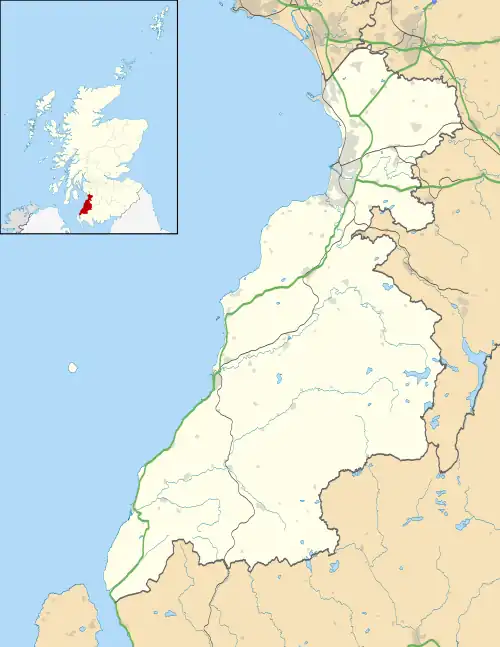| Barns of Ayr | |
|---|---|
| Ayr | |
 Barns of Ayr Location in South Ayrshire | |
| Coordinates | 55°27′39″N 04°37′39″W / 55.46083°N 4.62750°W |
| Type | Barracks |
| Site information | |
| Operator | Edward I's Army |
The Barns of Ayr was, according to Blind Harry in The Wallace, a site in Ayr, Scotland, which was used as English barracks.[1] According to Blind Harry, a number of Scottish barons of Ayrshire were called to a meeting with King Edward I of England at a barn used as an English military barracks, only to be massacred and hanged, including Sir Ronald Crawford Sheriff of Ayr, Sir Bryce Blair of Blair, Sir Neil Montgomerie of Cassillis, Crystal of Seton, and Sir Hugh Montgomerie.[2] In revenge, William Wallace burned the barracks with the English inside.[1]
This incident is now regarded by historians as unhistorical.[3] No such mass killing of Scots nobles by the English took place around this time, although Edward I of England did become more ruthless very near the end of his life, executing several of Robert the Bruce's supporters.[4] Book 4 of Barbour's epic poem The Bruce, an important near-contemporary source, mentions very briefly that "Sir Ranald of Crauford also, and Sir Bryce the Blair, were hanged in a barn at Ayr", but the context implies that this took place in 1306, the year after Wallace's execution.[5] Whether intentional or not, the purported incident seems to have been a counterfactual reorganization of plagiarized, inflated, roughly contemporary events.[3]
Some accounts describe Ronald Crawford as father of Reginald Crawford, a minor but known historical figure in the Wars of Scottish Independence. However, Reginald Crawford was made Sheriff of Ayr in 1296,[6] which is difficult to reconcile with the traditional story.
Barns of Ayr in popular culture
A version of this incident appears in the film Braveheart, where Wallace is shown as witnessing the mass hanging as a boy. This is even further wide of the mark as Scotland was not under English occupation during Wallace's boyhood.[7]
The location features in The Scottish Chiefs.[8]
Notes
- 1 2 "Barns of Ayr". CANMORE. Royal Commission on the Ancient and Historical Monuments of Scotland.
- ↑ Crome, p.47
- 1 2 Unmapping the Territory: Blind Hary's Wallace, Felicity Riddy's chapter in Edward Cowan's The Wallace Book (2007, ISBN 978-0-85976-652-4)
- ↑ John Prebble The Lion in the North
- ↑ Translation into modern English by George Eyre-Todd, p. 54
- ↑ Michael Penman, Robert the Bruce, King of the Scots
- ↑ Peter Traquair Freedom's Sword
- ↑ Porter, Jane (1921). The Scottish Chiefs. New York: Charles Scribner's Sons. pp. 174–182. ISBN 9780684193403.
References
- The Life and Heroick Actions of the Renoun'd Sir William Wallace, General and Governor of Scotland, Blind Harry (Blin Hary or Henry the Minstrel), original personal manuscript, c. 1475.
- Blind Harry's Wallace, William Hamilton of Gilbertfield, original publication 1722, Luath Press, Edinburgh, 1998, ISBN 0-946487-33-2.
- Crome, Sarah (1999). Scotland's First War of Independence. Auch Books. ISBN 978-0953631605.